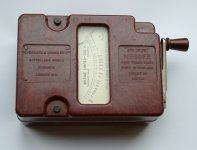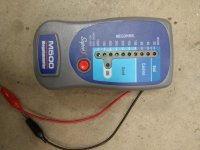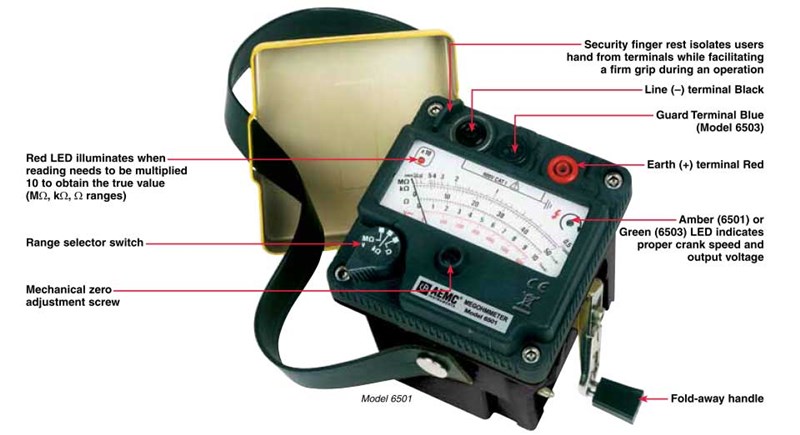I took a look on eBay at Meggers. A wide range of ages, manufacturers and types is for sale, both new & used. I was quite surprised at the low prices on some of the older/used hand cranked Meggers. I also saw a Chinese copy of a Biddle hand cranked Megger for small money. At those kinds of prices, a person could take a chance on a used/old instrument. IMO, if a person is going to work on old electric motors, motor controls, or generators, as well as old motorcycles and similar, a Megger is a good instrument to own.
I am guessing, like so much else, the old hand cranked Meggers were obsoleted by the new battery driven/digital instruments. I was always amazed at how warming or heating windings which had been wet, or disused over a long time, could bring up the Megger readings. I used to work with used open-frame synchronous generators on the jobs overseas. These were shipped with the rotor on a wood cradle, and the stator bolted to a hefty skid. It was rare that any effort to preserve the windings or protect them. After an ocean voyage, trucking, and who-knew-how rough the handling was, as well as standing in the open the Megger readings were usually abysmally low. Not a dead short to the machine frame, but low enough to cause concern. We used to make a tent out of canvas tarps and put construction heaters in the tent, blowing warm air into the tent and out under the bottom edges of the tarps. A few days of that, and the Megger readings usually came up nicely. In one case, we had really wet windings. The old style of generator windings were insulated with cambric (a cotton fabric) tape and Glyptol. The stuff was brittle with age, and after a trip with all sorts of rough handling and exposure to the weather at the site, the windings Meggered horribly low. I was going to do the usual thing and tent the windings and put a wood fired barrel stove inside the tent to make the heat. I had learned never to underestimate the local South Americans. Those mechanics and electricians worked on all sorts of things and made all sorts of repairs under conditions that were "not by the book". A South American electrician on the job hooked up an old Lincoln DC engine driven welder (an old Lincoln SA series) and we dried the windings by the method of internal heating. The local electrician had done it before, and knew that if too much current were applied to the windings, the heat could make steam in the layers of insulating material and windings, and could actually blow the windings apart.
The local electrician put a thermometer on the windings and went by feel with his hands, and the Lincoln welder did the trick. I later read about the method of drying windings by internal heating using welding power supplies, and it was an accepted method. I have never done it myself. If there was ever a constant thing on the South American jobs, it was the fact that the local mechanics and electricians were willing, resourceful, and great to work with. I learned a great deal from them at all levels. Another fairly constant thing on those jobs was having an old Lincoln SA series welder or two. Those machines had the magneto ignitions, so no batteries needed to crank them up and run them. I've started those old Lincolns with a hand crank many times, and always thought a magneto ignition was the greatest thing since sliced bread. Simple, and no battery to grow legs or go dead altogether.
Jim Rozen: Many years ago, a buddy and I were riding our BMW motorcycles on a long trip during a hot summer weekend. I was on an R 75/5, and he was on some oldtimer with the Earle's fork and magneto ignition. It had a 6 volt generator and battery for the lighting. We saw the thunderheads building as we rode along, and knew we'd be into a heavy thunderstorm before too long. Sure enough, we were. We were doing maybe 60 mph in the storm, figuring we'd run out from under it. My buddy pulled abreast of me, and pointed at his headlight, and got ahead of me. At the next highway overpass, we pulled off the road out of the rain. A brush had hung up in his bike's generator and it had not been charging the battery. We had plenty of tools on us, and I had some wire, so he used the battery in my R 75 to flash the field in his bike's generator. He got the generator making current again. He had been running along on the magneto, no need of the battery or generator. We agreed that I would ride behind his bike so my tail light would be visible, and he'd take the point, headlight out for the next 100 miles to let the battery soak up charge. I was impressed with my buddy's mechanical skills and knowledge. I was also impressed with the magneto ignition.
Many years later, I was on an antique motorcycle run. One fellow had a Matchless single from the early 50's. We were on some back road, putting along, when the guy on the Matchless was pulled off to the side and he was out in the road. I stopped to see if he needed help. He was laughing as he explained the battery holder had vibrated loose and the battery had been hanging by its leads. The engine kept on running nicely on the magneto and he'd run a good piece before he realize the Matchless was shedding parts. He was out in the road looking for bits of the battery holder. Gotta love those magneto ignitions.










